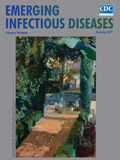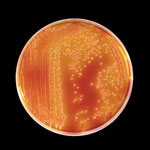
Volume 25, Number 11—November 2019
Etymologia
Etymologia: Serratia marcescens
Figures
Downloads
Article Metrics
Serratia marcescens, which can cause nosocomial outbreaks,and urinary tract and wound infections, is abundant in damp environments (Figure). It can be easily found in bathrooms, including shower corners and basins, where it appears as a pink–orange–red discoloration, due to the pigment known as prodigiosin. Serratia was discovered in Italy in 1819 when it affected polenta in a small town near Padua.
Bartolomeo Bizio, a Venetian pharmacist, studied the mode of transmission of the red substance and named this microorganism Serratia in honor of Serafino Serrati, who ran the first steamboat on the Arno River in 1795, anticipating the discovery of Robert Fulton in 1807. The word marcescens was chosen from Latin for the species name meaning to decay, reflecting the rapid deterioration of the pigment. Serratia marcescens was later renamed Monas prodigiosus in 1846, then Bacillus prodigiosus, before the original name was restored in the 1920s in recognition of the work of Bizio.
References
- Nazzaro G, Veraldi S. Serratia marcescens: an Italian story. Int J Dermatol. 2017;56:795–6.
- Sehdev PS, Donnenberg MS. Arcanum: the 19th-century Italian pharmacist pictured here was the first to characterize what are now known to be bacteria of the genus Serratia. Clin Infect Dis. 1999;29:770–925.
- Veraldi S, Nazzaro G. Skin ulcers caused by Serratia marcescens: three cases and a review of the literature. Eur J Dermatol. 2016;26:373–6.
Figure
Cite This ArticleOriginal Publication Date: 9/27/2019























.png)











No hay comentarios:
Publicar un comentario